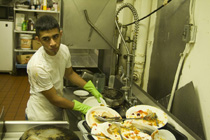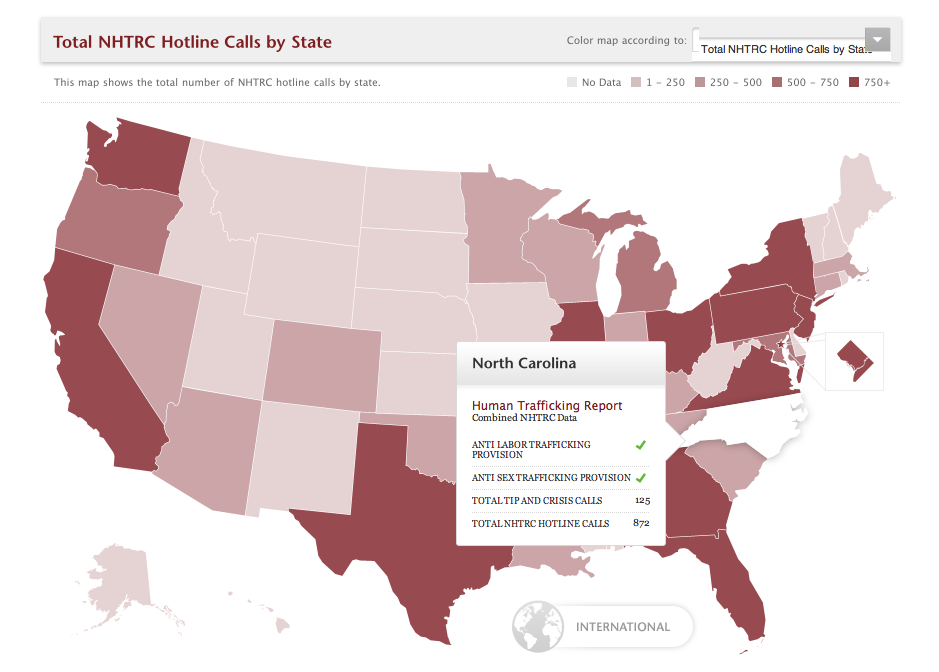There are more slaves today than in any other time in human history.
Saturday, February 18, 2012 I, along with AAUW Salisbury President, Brunetta Franklin, attended a workshop on Human Trafficking that AAUW Charlotte hosted. The workshop presentation featured speakers from NC STOP Human Trafficking, the FBI (Juanita Miller, Victim Assistance Coordinator) and the United States Attorney’s Office (Kenny Smith, Assistant US Attorney).
Human trafficking, or modern day slavery, does not only exist in third world countries. It also exists here in the United States and here in our region of the country. It is taking place at such an alarming rate that the State of North Carolina, the FBI and the United States Attorney’s Office have formed special units to “stop human trafficking”. ~ Diane Schneider (AAUW Charlotte Branch President)
Drugs can only be sold once, while women (and children) can be sold multiple times…
Listen to a Free Podcast by How Stuff Works on Human Trafficking (This podcast is on Human Trafficking and provides a high level overview of the problem)
Human trafficking is a form of modern-day slavery where people profit from the control and exploitation of others. As defined under U.S. federal law, victims of human trafficking include children involved in the sex trade, adults age 18 or over who are coerced or deceived into commercial sex acts, and anyone forced into different forms of “labor or services,” such as domestic workers held in a home, or farm-workers forced to labor against their will. The factors that each of these situations have in common are elements of force, fraud, or coercion that are used to control people. Then, that control is tied to inducing someone into commercial sex acts, or labor or services. Numerous people in the field have summed up the concept of human trafficking as “compelled service.” Every year, human traffickers generate billions of dollars in profits by victimizing millions of people around the world, and here in the United States. Human trafficking is considered to be one of the fastest growing criminal industries in the world. (From the Polaris Project website)
Why Trafficking Exists by Polaris Project
Myths & Misconceptions
Myth 1: Under the federal definition, trafficked persons can only be foreign nationals or are only immigrants from other countries.
Reality: The federal definition of human trafficking includes both U.S. citizens and foreign nationals – both are protected under the federal trafficking statutes and have been since the TVPA of 2000. Human trafficking encompasses both transnational trafficking that crosses borders and domestic or internal trafficking that occurs within a country. Statistics on the scope of trafficking in the U.S. are most thorough and accurate if they include both transnational and internal trafficking of U.S. citizens as well as foreign nationals.
Myth 2: Human trafficking is essentially a crime that must involve some form of travel, transportation, or movement across state or national borders.
Reality: The legal definition of trafficking, as defined under the federal trafficking statutes, does not require transportation. Although transportation may be involved as a control mechanism to keep victims in unfamiliar places, it is not a required element of the trafficking definition. Human trafficking is not synonymous with forced migration or smuggling. Instead, human trafficking is more accurately characterized as exploitation, a form of involuntary servitude, or “compelled service” where an individual’s will is overborne through force, fraud, or coercion.
Myth 3: Human trafficking is another term for human smuggling.
Reality: There are many fundamental differences between the crimes of human trafficking and human smuggling. Both are entirely separate federal crimes in the United States. Most notably, smuggling is a crime against a country’s borders, whereas human trafficking is a crime against a person. Also, while smuggling requires illegal border crossing, human trafficking involves commercial sex acts or labor or services that are induced through force, fraud, or coercion, regardless of whether or not transportation occurs.
Myth 4: There must be elements of physical restraint, physical force, or physical bondage when identifying a human trafficking situation.

Forms of forced labor have been found in numerous places in the United States, including cases of people forced to work in restaurants.
Reality: The legal definition of trafficking does not require physical restraint, bodily harm, or physical force. Psychological means of control, such as threats, fraud, or abuse of the legal process, are sufficient elements of the crime. Unlike the previous federal involuntary servitude statutes (U.S.C. 1584), the new federal crimes created by the Trafficking Victims Protection Act (TVPA) of 2000 were intended to address “subtler” forms of coercion and to broaden previous standards that only considered bodily harm. It is important for definitions of human trafficking in the U.S. and around the world to include a wide spectrum of forms of coercion in order for the definition to encompass all the ways that traffickers control victims.
Myth 5: Victims of human trafficking will immediately ask for help or assistance and will self-identify as a victim of a crime.
Reality: Victims of human trafficking often do not immediately seek help or self-identify as victims of a crime due to a variety of factors, including lack of trust, self-blame, or specific instructions by the traffickers regarding how to behave when talking to law enforcement or social services. It is important to avoid making a snap judgment about who is or who is not a trafficking victim based on first encounters. Trust often takes time to develop. Continued trust-building and patient interviewing is often required to get to the whole story and uncover the full experience of what a victim has gone through.
Myth 6: Human trafficking victims always come from situations of poverty or from small rural villages.
Reality: Although poverty can be a factor in human trafficking because it is often an indicator of vulnerability, poverty alone is not a single causal factor or universal indicator of a human trafficking victim. Trafficking victims can come from a range of income levels, and many may come from families with higher socioeconomic status.
Myth 7: Sex trafficking is the only form of human trafficking.
Reality: Elements of human trafficking can occur in the commercial sex industry as well as in situations of forced labor or services. The federal definition of human trafficking encompasses both “sex trafficking” and “labor trafficking,” and the crime can affect men and women, and children and adults.
Myth 8: Human trafficking only occurs in illegal underground industries.
Reality: Elements of human trafficking can be identified whenever the means of force, fraud, or coercion induce a person to perform commercial sex acts, or labor or services. Trafficking can occur in legal and legitimate business settings as well as underground markets.
Myth 9: If the trafficked person consented to be in their initial situation or was informed about what type of labor they would be doing or that commercial sex would be involved, then it cannot be human trafficking or against their will because they “knew better.”
Reality: A victim cannot consent to be in a situation of human trafficking. Initial consent to commercial sex or a labor setting prior to acts of force, fraud, or coercion (or if the victim is a minor in a sex trafficking situation) is not relevant to the crime, nor is payment.
Myth 10: Foreign national trafficking victims are always undocumented immigrants or here in this country illegally.
Reality: Foreign national trafficked persons can be in the United States through either legal or illegal means. Although some foreign national victims are undocumented, a significant percentage may have legitimate visas for various purposes. Not all foreign national victims are undocumented.
Only 27 states have anti-trafficking legislation.
Sex Trafficking in the US takes place in Massage Parlors, on Internet Sites, Residential Brothels, Hostess & Strip Clubs, Escort Services, Truck Stops and on the streets.
The documentary Very Young Girls was shown at the workshop
Signs & Symptoms
If you see any of these red flags, contact the National Human Trafficking Resource Center hotline at 1-888-3737-888 to report the situation.
Common Work and Living Conditions: The Individual(s) in Question
- Is not free to leave or come and go as he/she wishes
- Is under 18 and is providing commercial sex acts
- Is in the commercial sex industry and has a pimp / manager
- Is unpaid, paid very little, or paid only through tips
- Works excessively long and/or unusual hours
- Is not allowed breaks or suffers under unusual restrictions at work
- Owes a large debt and is unable to pay it off
- Was recruited through false promises concerning the nature and conditions of his/her work
- High security measures exist in the work and/or living locations (e.g. opaque windows, boarded up windows, bars on windows, barbed wire, security cameras, etc.)
Poor Mental Health or Abnormal Behavior
- Is fearful, anxious, depressed, submissive, tense, or nervous/paranoid
- Exhibits unusually fearful or anxious behavior after bringing up law enforcement
- Avoids eye contact
Poor Physical Health
- Lacks health care
- Appears malnourished
- Shows signs of physical and/or sexual abuse, physical restraint, confinement, or torture
Lack of Control
- Has few or no personal possessions
- Is not in control of his/her own money, no financial records, or bank account
- Is not in control of his/her own identification documents (ID or passport)
- Is not allowed or able to speak for themselves (a third party may insist on being present and/or translating)
Other
- Claims of just visiting and inability to clarify where he/she is staying/address
- Lack of knowledge of whereabouts and/or do not know what city he/she is in
- Loss of sense of time
- Has numerous inconsistencies in his/her story



Pingback: Salisbury, N.C.: A Human Trafficking Stop Along the I-85 Corridor | Rowan Free Press
I see your website doesn’t rank high in google, but your articles can get into
top 10. You should find the right longtail keywords before
you write a post. How to find super easy longtail keywords?
Search in google for; Fasrixo’s tools
“Plenty of useful information here. I am sending it to a
few friends ans additionally sharing in delicious.
And certainly, thank you in your effort!”